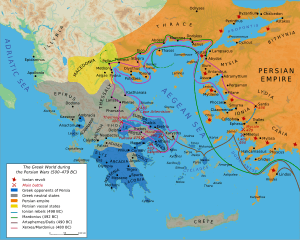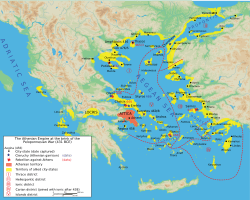Battle of the Eurymedon facts for kids
Quick facts for kids Battle of the Eurymedon |
|||||||
|---|---|---|---|---|---|---|---|
| Part of the Wars of the Delian League | |||||||
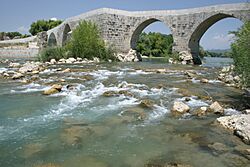 The Eurymedon River, near Aspendos |
|||||||
|
|||||||
| Belligerents | |||||||
| Delian League | Achaemenid Empire | ||||||
| Commanders and leaders | |||||||
| Cimon | Tithraustes, Pherendatis † |
||||||
| Strength | |||||||
| 200 ships | 200–350 ships | ||||||
| Casualties and losses | |||||||
| Unknown | 200 ships captured and destroyed | ||||||
The Battle of the Eurymedon was a huge fight that happened both on land and at sea. It was between the Delian League, led by Athens, and the mighty Persian Empire. This important battle took place around 469 or 466 BCE. It happened near the mouth of the Eurymedon River, which is now called the Köprüçay River in modern-day Turkey. This battle was a key part of the Wars of the Delian League, which were themselves part of the larger Greco-Persian Wars.
The Delian League was a group of Greek city-states. Athens and its allies formed it to keep fighting Persia. This war had started with two big Persian invasions of Greece. After the Plataea and Mycale, the Greeks went on the attack. The Delian League then took charge. They continued to attack Persian bases across the Aegean Sea for about ten years.
Around 469 or 466 BCE, the Persians started gathering a large army and navy. They planned a big attack against the Greeks. Their goal was likely to take back Greek cities in Asia Minor. This would give them naval bases to launch more attacks into the Aegean. When the Athenian general Cimon heard about this, he sailed with 200 triremes (warships). He went to Phaselis in Pamphylia, a city that then joined the Delian League. This stopped the Persian plan right at the start.
Cimon then decided to attack the Persians first near the Eurymedon River. He sailed into the river's mouth and quickly defeated the Persian fleet. Most Persian sailors ran to their army on land. Cimon then landed his Greek soldiers. They attacked the Persian army, which was also defeated. The Greeks captured the Persian camp and many prisoners. They also destroyed 200 Persian warships that were pulled onto the beach. This amazing double victory really discouraged the Persians. It stopped them from attacking the Aegean Sea until at least 451 BCE. However, the Delian League didn't push their advantage much further. Other events in the Greek world needed their attention.
Contents
Understanding the Past: Sources and Dates
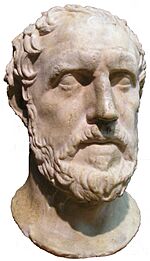
Learning about ancient Greek military history can be tricky. Especially for the time between the second Persian invasion of Greece (480–479 BCE) and the Peloponnesian War (431-404 BCE). This period was mostly peaceful and successful for Greece. The best source we have is History of the Peloponnesian War by Thucydides. He was alive during these times, so his account is usually trusted. Thucydides only mentions this period briefly. He was more focused on explaining why the Peloponnesian War started. His account doesn't give many exact dates.
Other details come from Plutarch's Parallel Lives. He wrote biographies of famous people like Cimon. Plutarch wrote much later, about 600 years after the events. But he often named his sources, which helps historians check his information. He used many old histories that are now lost.
Another source is Bibliotheca historica by Diodorus Siculus. He wrote in the 1st century BCE. Much of his information comes from an earlier historian named Ephorus. Modern historians don't always trust Ephorus's work. So, Diodorus is not always the best source for this period.
Historians also use archaeological finds, like old inscriptions. Lists of payments from members of the Delian League are very helpful.
When Did the Battle Happen?
Historians don't fully agree on the exact date of the Battle of Eurymedon. Most think it was either 469 or 466 BCE. We know for sure it happened before the revolt of Thasos, an ally of Athens, around 465 BCE. Thucydides mentions the Eurymedon battle after the revolt of Naxos. He connects Naxos's revolt with Themistocles fleeing to Persia and King Xerxes I dying in 465 BCE. This suggests the battle was no earlier than 466 BCE. But the date of Naxos's revolt is also debated. And Thucydides might not have listed events in perfect order.
Some historians think the battle happened in 469 BCE. This is because Cimon, the Athenian commander, and other generals were judges in a play competition in spring 468 BCE. Many believe this happened because they had just won a great victory. The Battle of Eurymedon is the most likely victory. But critics say this isn't direct proof. They prefer a date closer to the Thasos revolt in 465 BCE.
Why the Wars Started: Background
The Greco-Persian Wars began because the Persian Empire conquered Greek cities in Asia Minor. This included Ionia, taken by Cyrus the Great after 550 BCE. The Persians found it hard to rule the Ionians. They often put a tyrant (a ruler who took power by force) in charge of each city. By 500 BCE, Ionia was ready to rebel. The tension exploded because of Aristagoras, the tyrant of Miletus. After a failed Persian mission in 499 BCE, Aristagoras declared Miletus a democracy. This sparked similar revolts across Ionia, starting the Ionian Revolt.
The Greek states of Athens and Eretria got involved. In 498 BCE, they helped capture and burn Sardis, a Persian capital. The Ionian Revolt continued for five more years without outside help. The Persians finally crushed it. But Persian King Darius the Great decided to punish Athens and Eretria for helping the rebels. The Ionian Revolt had threatened his empire. So, Darius planned to conquer Greece, starting with Athens and Eretria.
Over the next 20 years, Persia launched two invasions of Greece. These included some of history's most famous battles. During the first invasion, Thrace, Macedon, and the Aegean islands became part of the Persian Empire. Eretria was destroyed. But the invasion ended in 490 BCE with Athens' big win at the Battle of Marathon. Darius died, and his son Xerxes I took over. Xerxes led the second invasion in 480 BCE. He brought a huge army and navy to Greece.
The Greeks who fought back (the 'Allies') lost battles at Thermopylae (land) and Artemisium (sea). Most of Greece, except the Peloponnesus, fell to Persia. But then, the Persians suffered a huge defeat at the Battle of Salamis. The next year, 479 BCE, the Allies gathered a massive Greek army. They defeated the Persians at the Battle of Plataea. This ended the invasion and the threat to Greece.
Tradition says that on the same day as Plataea, the Allied fleet defeated the remaining Persian fleet at the Battle of Mycale. This marked the end of the Persian invasion. It also started the next phase of the wars: the Greek counterattack. After Mycale, the Greek cities in Asia Minor revolted again. The Persians could not stop them. The Allied fleet then sailed to the Thracian Chersonese, still held by Persians. They captured the town of Sestos. In 478 BCE, the Allies captured Byzantium (modern-day Istanbul). This was the last action of the Greek alliance that defeated Persia.
After Byzantium, Sparta wanted to stop fighting. Spartans felt that with mainland Greece and the Greek cities of Asia Minor free, the war's goal was met. They also thought it would be too hard to keep the Asian Greeks safe long-term. Sparta had led the alliance against Xerxes. With Sparta leaving, Athens took over leadership. A meeting was held on the holy island of Delos to form a new alliance. This alliance, including many Aegean islands, was called the 'First Athenian Alliance'. It's better known as the Delian League. Thucydides said its goal was to "avenge the wrongs they suffered by ravaging the territory of the king." The Delian League spent the next decade removing Persian soldiers from Thrace. They also expanded the League's control in the Aegean.
Getting Ready for Battle: Prelude
Once most Persian forces in Europe were gone, Athens started to expand the Delian League into Asia Minor. Islands like Samos, Chios, and Lesbos joined the original Greek alliance after Mycale. They likely became early members of the Delian League. It's not clear exactly when other Greek cities in Asia Minor joined, but they did. Thucydides mentions Ionians at Byzantium in 478 BCE. So, some Ionian cities might have joined early that year. The Athenian politician Aristides died around 468 BCE while on public business in Pontus. Since Aristides managed the League's money, this trip might have been about expanding the League into Asia Minor.
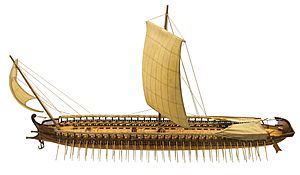
Cimon's Eurymedon campaign likely started because Persia was gathering a large fleet and army. They were near Aspendos, by the Eurymedon River. Historians believe the Persians were planning an attack. Cimon's campaign was launched to stop this new threat. Some suggest this was Persia's first big attempt to fight back since their second invasion failed. Internal problems in the Persian Empire might have delayed this campaign.
Ancient naval warfare depended on rowers. Ships needed to land every few days for food and water. This limited how far a fleet could go. Navies could only operate near safe bases. So, the Persian forces at Aspendos probably planned to move along the coast of Asia Minor. They would capture each city, one by one. This would let their navy operate in Ionia again. Alexander the Great used a similar strategy much later, but in reverse. He didn't have a strong navy. So, he captured coastal ports to deny them to the Persian navy.
Plutarch says Cimon sailed from Cnidus (in Caria) with 200 triremes. It's very likely Athens knew about a coming Persian campaign. No other League business would need such a large force. Cimon might have waited in Caria, expecting the Persians to march into Ionia. According to Plutarch, Cimon sailed to the Greek city of Phaselis (in Lycia). They refused to let him in. So, he started attacking their lands. But with help from the soldiers from Chios, Phaselis agreed to join the League. They would send troops and pay Athens ten talents (a form of money).
Cimon's early move to capture Phaselis suggests he expected the Persians to attack coastal cities. The presence of both army and navy at Aspendos probably convinced him there would be no immediate attack on Ionia. By taking Phaselis, the easternmost Greek city in Asia Minor, he blocked the Persian plan. He denied them the first naval base they needed. Taking further action, Cimon then decided to directly attack the Persian fleet at Aspendos.
Who Fought: Opposing Forces
The Greek Side
Plutarch states that the Delian League fleet had 200 triremes. These were sleek Athenian ships. They were designed for ramming enemy ships. But Cimon had changed them to be better for boarding actions (where soldiers jump onto enemy ships).
A trireme usually had 200 men. This included 14 marines (soldiers who fight on ships). Persian ships often carried more marines, sometimes 30 or 40. This shows a trireme could carry about 40-45 soldiers. Too much weight could make them unstable. So, the League fleet likely had around 5,000 hoplite marines (heavily armed Greek soldiers).
The Persian Side
Historians have different ideas about the size of the Persian fleet. Thucydides, who is usually very reliable, says there were 200 Phoenician ships. Plutarch gives numbers of 350 ships from Ephorus and 600 from Phanodemus. Plutarch also says the Persian fleet was waiting for 80 more Phoenician ships from Cyprus. While Thucydides is generally preferred, it's possible the Persians were waiting for more ships. This would explain why Cimon attacked them first.
Ancient sources don't give numbers for the Persian land army. However, the number of Persian marines on their ships was probably similar to the Greek marines, around 5,000. Plutarch says Tithraustes commanded the Persian fleet and Pherendatis led the army. But he also mentions that Callisthenes named Ariomandes as the overall commander.
The Battle of Eurymedon
Thucydides gives very few details about this battle. The most trusted detailed story comes from Plutarch. According to Plutarch, the Persian fleet was anchored near the Eurymedon River's mouth. They were waiting for 80 Phoenician ships from Cyprus. Cimon, sailing from Phaselis, decided to attack the Persians before these extra ships arrived. The Persian fleet tried to avoid fighting and retreated into the river.
However, Cimon kept pushing towards them, so the Persians had to fight. No matter how many ships they had, the Greek battle line quickly broke through the Persian ships. The Persian ships then turned and headed for the river bank. They ran their ships aground, and the crews ran to find safety with their army nearby. Some ships might have been captured or sunk during the naval battle. But it seems most were able to reach land.
The Persian army then started moving towards the Greek fleet. The Greeks had likely also landed to capture the Persian ships. Even though his troops were tired from the first fight, Cimon saw "that his men were excited by their victory, and eager to fight the Barbarians." So, he landed his marines and attacked the Persian army. At first, the Persian line held against the Athenian attack. But eventually, just like at the Battle of Mycale, the heavily armored Greek hoplites proved stronger. They defeated the Persian army. The Persians fled back to their camp, but the victorious Greeks captured them and their camp.
Thucydides says 200 Phoenician ships were captured and destroyed. It's unlikely this happened during the short naval battle. These were probably the ships that landed and were then burned, like at Mycale. Plutarch says 200 ships were captured, plus others that were destroyed or fled. It's possible "destroyed" means sunk during the battle. The Greeks would have destroyed the captured ships too. There are no numbers in ancient sources for how many soldiers died on either side.
Plutarch says that after his double victory, Cimon "still went on competing with his own victories." Cimon supposedly sailed with the Greek fleet very quickly. He wanted to stop the 80 Phoenician ships the Persians were expecting. He surprised them and captured or destroyed the entire fleet. However, Thucydides does not mention this extra battle. Some historians doubt if it really happened.
What Happened Next: Aftermath
According to Plutarch, some stories say the Persian king (who was still Xerxes at the time) agreed to a humiliating peace treaty after the Eurymedon battle. But Plutarch also admits that other writers said no such peace was made then. A more likely time for a peace treaty would have been after the Cyprus campaign of 450 BCE. Plutarch suggests that the Persian king acted as if he had made a humiliating peace. This was because he was so afraid to fight the Greeks again. Most modern historians think it's unlikely a peace treaty was made right after Eurymedon.
The Battle of Eurymedon was a very important victory for the Delian League. It probably ended the threat of another Persian invasion of Greece for good. It also seemed to stop any Persian attempts to take back the Greek cities in Asia Minor until at least 451 BCE. More cities in Asia Minor, especially from Caria, probably joined the Delian League after Cimon's campaign there.
Even with Cimon's huge victory, a kind of stalemate developed between Persia and the League. The Greeks didn't seem to push their advantage much further. If the later date of 466 BCE for the Eurymedon campaign is correct, this might be because of the revolt in Thasos. Resources were sent away from Asia Minor to stop the Thasians from leaving the League. On the other hand, as Plutarch suggests, the Persians used a very defensive strategy in the Aegean for the next 15 years. The Persian fleet was mostly absent from the Aegean until 451 BCE. Greek ships could sail freely along the coasts of Asia Minor. The next major Delian League campaign against the Persians only happened in 460 BCE. That's when Athens decided to support a revolt in the Egyptian part of the Persian empire. This campaign lasted six years and ended badly for the Greeks.
Images for kids


